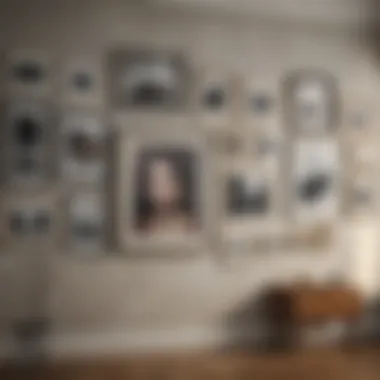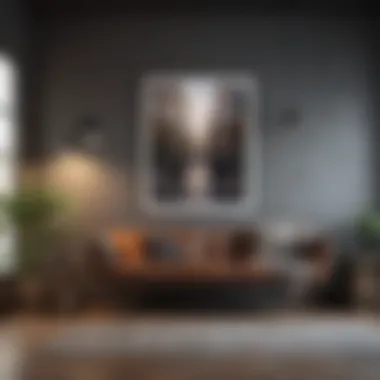Mastering the Art of Picture Hanging: A Comprehensive Guide


Intro
Hanging pictures on a wall goes beyond merely placing frames in random spots. It requires a thoughtful approach to achieve a balanced and aesthetically pleasing arrangement. This guide offers practical steps and considerations to enhance your wall decor with ease. Many homeowners and design enthusiasts encounter challenges when trying to select the right locations, choose proper tools, and implement effective hanging methods. By understanding these essential aspects, you will be able to create a cohesive and visually appealing display that reflects your personal style.
Home Design Inspiration
When embarking on the journey of hanging pictures on your wall, one should first explore the broader context of home design. Different architectural styles often dictate the choice of artwork and the manner of display. Whether your space exudes modern minimalism or classic elegance, the design inspiration should align seamlessly with your picture hanging strategy.
Architectural Styles
- Modern: Minimalist spaces typically benefit from large, singular pieces that serve as focal points. Oversized canvas art can create an impactful presence on a white wall.
- Traditional: In a more classical environment, a gallery wall featuring frames of varied sizes and styles often works well. This mix should still maintain a sense of harmony, perhaps through a consistent color palette.
- Industrial: Artwork in industrial spaces frequently employs metal or rustic materials, complementing the rawness of the surroundings. Consider using simple frames in matte black or natural wood to enhance the decor.
Innovative Decor Trends
Each year brings fresh ideas to the forefront of interior design. As you think about hanging pictures, consider the following trends:
- Eclectic Gallery Walls: Combine various art styles, sizes, and textures. The key lies in creating diversity while ensuring an overarching theme or color scheme.
- Mixed Media Displays: Experiment with textures by incorporating fabric, tapestries, or three-dimensional elements along with traditional framed art. This approach adds depth and interest.
- Sustainable Choices: Opt for locally sourced art or prints that emphasize eco-friendly themes. This aligns with a growing trend towards sustainability in home decor.
Choosing the Right Location
Selecting an optimal location for your artwork is crucial. Assess the size of each space and understand how lighting influences visibility. Natural light can enhance textures and colors, while poor lighting can detract from details. Keep an eye on these factors to maximize the impact of your display.
Preparing Tools and Materials
To hang pictures effectively, you’ll need to gather proper tools. Basic requirements often include:
- Measuring tape
- Level
- Hammer
- Picture hooks or nails
Before beginning, ensure you have everything ready so the process is smooth. Having the right tools can significantly reduce stress during the project.
"A well-composed wall display reflects personal taste and enhances the overall aesthetic of the space.”
Hanging Methods
There are various methods to hang pictures, each suitable for different wall types and picture sizes. Here are popular options you might consider:
- Nails: Best for lighter frames. Ensure they are driven into wall studs for stability.
- Command Strips: Excellent for renters who may want to avoid damaging the walls.
- Wires and Hooks: Good for larger pieces, allowing flexibility in the arrangement.
End
Hanging pictures demands a combination of planning, creativity, and technique. By assessing your space, choosing appropriate materials, and implementing effective methods, you can enhance your living areas with thoughtfully arranged artwork that resonates with your style. Whether you opt for a minimalist approach or a more eclectic mix, the art of hanging pictures can truly elevate your home design.
Prolusion to Picture Hanging
Hanging pictures may seem like a simple task, yet it holds significant weight in home design and personal expression. Understanding the fundamentals of picture hanging can enhance both the aesthetic appeal and overall environment of your living space. This article aims to explain these fundamentals, ensuring that readers appreciate the role of pictures in enhancing their interiors.
The Importance of Artwork in Home Design
Artworks serve as pivotal elements in any room. They have the power to transform the ambiance, showcase personal taste, and provide focal points in a design scheme. When carefully selected and displayed, art can evoke emotions and inspire dialogues among guests.
Furthermore, incorporating art thoughtfully can tie together various elements within a space, such as color schemes and furnishings. This can lead to a harmonious and cohesive look that transcends mere decoration. Additionally, well-displayed artwork can create depth and interest, making a room feel more inviting. To realize these benefits, it is crucial to approach the arrangement and hanging process with intent.
Choosing the Right Pictures for Your Space
The selection of pictures is paramount in achieving a desirable outcome in your design. When considering which images to display, think about the themes that resonate with you and the atmosphere you wish to create. Various factors will influence your choices, including:
- Size and Scale: Choose pieces that complement the dimensions of your walls and furniture. Large artworks can serve as statements, while smaller pieces may work well in clusters.
- Color Palette: Select pictures that align with or enhance your current color scheme. This can create an integrated appearance.
- Style and Theme: Consider how the artwork fits into the overall design style of your home. From modern to traditional, artworks should reflect the essence of the space.
While selecting art, it can be beneficial to visualize how the pieces will look in different locations. Mock-ups or digital tools can aid in this process, providing clarity in decision-making.
In summary, understanding the significance of picture hanging and the thoughtful selection of artworks is crucial. These elements pave the way for a successful display that resonates with personal style and complements the living environment.


Preparation for Hanging Pictures
Preparation is a crucial step when it comes to hanging pictures on your wall. The way you prepare will ultimately affect the visual appeal and durability of your displays. This section will discuss the key elements involved in getting ready to hang pictures, such as selecting the ideal locations in your home and gathering the necessary tools and materials.
Selecting the Perfect Location
Choosing where to hang pictures is essential. The right location can enhance the overall aesthetic of your space and create a sense of harmony. Factors like light and available wall space are fundamental here.
Considering Natural Light
Natural light plays a significant role in how artwork is perceived. When you hang pictures in areas that receive adequate light, it can help to highlight colors and details in the artwork. If pictures are placed in dark areas, they may appear dull and lose their appeal.
A key characteristic of considering natural light is the way sunlight interacts with art. This can create interesting shadows and reflections that add depth to the display. However, too much direct sunlight can fade colors. To strike a balance, think about soft, indirect light to showcase your art effectively.
Understanding Wall Space
Understanding the wall space where you intend to hang pictures is another vital aspect. Evaluating the dimensions of your walls aids in making informed decisions. You will want to avoid overcrowding, which can make a room feel cluttered.
A key characteristic here is the proportion of your artwork to the wall dimensions. Properly related sizes help create a visually pleasing arrangement. On the flip side, too expansive a picture can overpower a small space, while small prints may get lost on larger walls.
Gathering Necessary Tools and Materials
Once you have decided on the location, gathering the necessary tools and materials comes next. This stage is imperative for ensuring your hanging process is smooth and effective. Essential tools include hammers, levels, and measuring tapes.
Hammers, Levels, and Measuring Tape
These tools are foundational for a successful hanging process. A hammer is needed to drive in nails or hooks, while a level helps ensure that your pictures are straight. Accurate measurements are crucial, and that’s where the measuring tape comes in.
The key characteristic of using a hammer, level, and tape is that they help achieve precision in your arrangement. For instance, using a level prevents any slouching frames. The downside, though, is that these tools can require a bit of practice to use effectively, especially for those who are not accustomed to DIY tasks.
Hanging Hardware Options
Choosing the right hanging hardware is another essential consideration. Various types of hardware exist, from simple picture hooks to more complex systems designed to hold heavier pieces. This selection directly affects how sturdy and secure your picture displays will be.
A prominent characteristic of different hanging hardware is that each serves specific purposes. For example, wall anchors provide extra support in drywall, while picture locks secure frames against accidental falls. However, some hardware may require drilling holes, which could be undesirable for renters or individuals averse to extensive modifications to their walls.
Effective preparation is the backbone of a successful picture hanging project. Adequate planning sets the stage for a successful, aesthetically pleasing display.
These aspects of preparation ensure that you lay a strong foundation for the hanging of pictures. Evaluating natural light, wall space, and tools will help you achieve your desired look.
Techniques for Hanging Pictures
Hanging pictures correctly is essential for creating an appealing space. Various techniques provide methods that cater to different types of walls, artworks, and personal preferences. Understanding these techniques helps in selecting the best approach to secure your pictures effectively while ensuring aesthetic appeal. This section will detail three popular methods for hanging pictures: using nails and picture hooks, employing adhesive strips, and utilizing frames with built-in hangers. Each of these techniques has its own advantages and considerations, making them suitable for different contexts and preferences.
Using Nails and Picture Hooks
Nails and picture hooks are among the traditional methods for hanging artwork. This method offers a sturdy and reliable way to display pictures, ensuring they remain securely in place.
- Nails: Standard nails are simple to use and can hold lighter frames without any additional hardware. To use them, you simply hammer the nail into the wall, leaving enough of the nail exposed to hold the picture.
- Picture Hooks: These are designed specifically for hanging frames. They provide a better weight distribution compared to nails alone and can hold more substantial artworks. By simply driving a picture hook into the wall, you can easily hang or remove pictures with minimal effort.
It is important to select the right type of nail or hook based on the weight of the picture. For heavier frames, consider using wall anchors to provide additional support and prevent damage to the wall. When utilizing nails or hooks, ensure they are placed at the correct height to enhance the visual appeal.
Employing Adhesive Strips
Adhesive strips offer a modern solution for hanging pictures, favored especially in spaces where wall damage is a concern. These strips are easy to apply and remove, making them ideal for renters or those who frequently change their decor.
The advantages include:
- Easy Application: Just peel and stick.
- Damage-Free Removal: They leave no marks or residue when removed.
- Versatile Use: Suitable for a range of surfaces including drywall and plaster.
When choosing adhesive strips, ensure they are rated for the weight of your artwork. For optimal results, clean the wall surface before application to promote better adhesion. Follow the package instructions, as different brands may have varying guidelines.
Utilizing Frames with Built-In Hangers


Frames with built-in hangers offer convenience and style. These frames often come pre-equipped with hardware, making the hanging process straightforward and efficient.
Here are some benefits of this method:
- Simplicity: No additional hardware is needed, allowing for quick setup.
- Consistent Display: Frames with built-in hangers often ensure that pictures hang straight and at the desired height.
- Design Cohesion: Many frames are designed to complement each other, making it easy to create cohesive displays.
When using frames with built-in hangers, read the manufacturer's instructions for the best results. Check the weight limit and ensure your wall surface is suitable for the frame's hanger type. This technique not only streamlines the process but enhances the overall look of your space.
"Choosing the right hanging technique can turn simple artwork into a focal point that enhances your interior design."
Creating Picture Arrangements
Creating picture arrangements is a critical part of decorating your home. The way in which you display your artwork and photographs can impact the overall aesthetics of a room. A well-arranged wall can create a sense of cohesion and purpose, guiding the viewer’s eye across the space. On the other hand, a haphazard display can make a space feel disorganized and chaotic.
Effective picture arrangements enhance the interior decor by allowing the artwork to complement the surroundings rather than detract from them. This section explores important methodologies for arranging pictures, especially through gallery walls and the use of symmetry or asymmetry.
Your artwork tells a story. How you arrange it can change that narrative entirely.
Planning a Gallery Wall
A gallery wall can serve as a stunning focal point in any room. When planning a gallery wall, it is essential to consider the balance of sizes and shapes.
Balancing Sizes and Shapes
Balancing sizes and shapes is essential for a visually pleasing gallery wall. Diversity in dimensions can create interest and texture within your design. When you mix large and small frames, you draw attention to specific pieces while maintaining overall cohesion.
For example, if a big photograph is flanked by smaller images, it enhances the impact of that larger piece. This method is popular because it is visually engaging. However, if not done thoughtfully, it can lead to discomfort in viewing.
A unique feature of balancing sizes and shapes is that it allows creative freedom. You can play with orientation as well, including both portrait and landscape frames. The primary advantage here is the invitation to experiment. The main disadvantage is that it can become overwhelming if too many sizes are included without some unifying element.
Achieving Visual Harmony
Achieving visual harmony is another key factor in effective picture arrangements. This concept revolves around creating a cohesive look. The key characteristic of visual harmony is consistent elements that tie the artwork together, such as color, theme, or style.
This approach is beneficial because it creates a unified appearance, making the gallery wall feel intentional and curated. A unique strategy for achieving visual harmony is to select pieces that share a common color palette. It allows the different items to interact positively one with another.
However, overemphasizing harmony may lead to a lack of contrast, which is equally important for interest. You should balance harmony with a touch of spontaneity to keep the display lively.
Using Symmetry vs. Asymmetry
The choice between symmetry and asymmetry is fundamental in picture arrangements. Symmetrical arrangements provide a sense of order and balance. They work well in formal settings or when you desire a neat appearance.
Conversely, asymmetric arrangements can evoke a more dynamic energy. They invite curiosity and movement, making spaces feel more inviting. When deciding which method to use, assess the atmosphere you want in your room. Symmetry provides tranquility, while asymmetry offers vibrancy.
Both approaches have their merits. However, the key is to ensure that whichever method you choose aligns with your overall design ethos. Discovering your unique style is vital in transforming walls into personal statements.
Best Practices for Hanging Pictures
Hanging pictures is not just about placing items on a wall; it requires thoughtful consideration of various elements. Best practices can lead to a more polished and professional look in any space. Knowing how to properly hang pictures enhances aesthetics. It can make a room appear more organized and inviting. There are practical advantages to following these guidelines, which contribute to a satisfying overall layout.
Proper Height and Spacing
When hanging pictures, the height at which you place them is critical. A common rule is to position artworks at eye level. This generally means about 57 to 60 inches from the floor to the center of the piece. The average person's eye level falls within this range, creating a natural view.
Spacing between pictures also matters. Aim for about 2 to 5 inches between each frame for a cohesive look. This prevents the arrangement from feeling cluttered. If you are grouping different sizes or styles, maintain a consistent spacing to give a sense of order.
- Tips for Height and Spacing:
- Measure before hanging to avoid mistakes.
- Use painter's tape to outline the area on the wall.
- Observe how light affects the art at different heights.
Adapting to Different Wall Types


Different wall materials require varying techniques and tools for hanging pictures. Knowing how to adapt to these wall types will bring better results and protect your artwork.
Drywall Considerations
Drywall is the most common wall type in homes. It is relatively easy to hang pictures on drywall using standard nails or picture hooks. However, it is essential to recognize the weight limit. Installing heavy items requires anchors or screws to ensure they stay securely fixed without damaging the wall.
The main characteristic of drywall is its softer composition compared to other materials. This makes it ideal for easy fastening with light to medium-weight frames but can be a disadvantage when handling heavier art.
- Advantages of Drywall:
- Simple to anchor hooks with basic tools.
- Suitable for most lightweight and medium-weight artworks.
Brick and Concrete Walls
Hanging pictures on brick or concrete walls presents unique challenges. These walls are much sturdier. As such, one needs specialized hardware, such as masonry anchors or screws. Drilling is often required, which can be more complicated than drywall installation.
The key characteristic of brick and concrete walls is their durability. This allows you to hang heavier items without concerns of falling. However, the limitations include a demanding installation process and the potential for spalling if not done correctly.
- Advantages of Brick and Concrete Walls:
- Excellent for holding heavy frames without risk.
- Provides a unique industrial aesthetic that many enjoy.
In summary, understanding the unique requirements of the wall type is essential to achieve a successful hanging outcome. Proper techniques align with the materials to ensure both functionality and visual appeal.
Maintaining Your Picture Displays
Maintaining your picture displays is essential to ensure that your artwork continues to look its best. Whether you have a single prized piece or an extensive gallery wall, ongoing care can help preserve the integrity of the art and the quality of its display. Regular maintenance enhances both aesthetic appeal and longevity of your displays, creating an inviting atmosphere in your home.
One primary benefit of this focus is safety. Pictures that are not securely hung can fall, leading to damage to the artwork and potentially injuring anyone nearby. Additionally, well-maintained displays contribute to the overall coherence and beauty of your interior design. Keeping an organized and clean presentation showcases your taste and commitment to creating a harmonious living space.
Regular Checks for Stability
Performing regular checks on your picture displays is a crucial practice. It's important to ensure that every piece remains secure on the wall. Over time, factors such as temperature changes, humidity, or even minor vibrations from everyday life can affect the stability of your hanging methods.
Set a reminder to check hung pictures approximately every six months. Look for any signs of loosening or misalignment. If a piece feels wobbly or tilted, take immediate action to remedy the issue.
To assess stability:
- Gently press on the edges of the frames to see if they shift.
- Inspect the hanging hardware for wear and tear.
- Replace any damaged hooks or anchors right away.
- Tighten screws or nails as needed.
Cleaning and Caring for Artworks
Cleaning and caring for your artworks is equally significant. Dust and grime can accumulate on frames and glass, obscuring the beauty of your displays. Regular cleaning not only keeps works looking fresh but also helps prevent potential damage to the art itself.
To maintain your artwork:
- Use a soft, dry cloth to gently wipe away dust from frames and surfaces.
- For glass fronted pieces, a glass cleaner can be used. Ensure it is safe for use on art, avoiding sprays that can affect the artwork.
- Avoid using harsh chemicals or abrasive materials that can damage frames or art.
- If your artwork is particularly valuable, consider professional cleaning services.
Ensuring the proper upkeep of your displays adds to their longevity and preserves their beauty while reflecting your commitment to your living space.
Closure
The conclusion serves an essential role in bringing together the various elements discussed throughout the article on how to hang pictures effectively. It encapsulates the key steps and insights that readers can employ to transform their living spaces using artwork. By understanding the preparation, techniques, and best practices, individuals can enjoy a more harmonious environment that reflects their personal style and creativity.
Recapping the Key Steps
- Preparation: Understand the significance of selecting the right location and gathering the necessary tools. This foundational step greatly affects the overall presentation.
- Techniques: Familiarize yourself with different hanging methods like using nails, adhesive strips, or built-in hangers. Each method has its advantages depending on the wall type and picture weight.
- Creating Arrangements: Plan your layout carefully, whether opting for a gallery wall or a more symmetrical display. Ensuring visual balance is crucial for a pleasing aesthetic.
- Best Practices: Take into account height and spacing guidelines for a polished look. Adapt your approach based on the wall material, whether it is drywall, brick, or concrete.
- Maintenance: Regularly check for stability and keep your artworks clean to preserve their beauty and longevity.
Encouragement to Experiment with Design
After understanding the basic principles of hanging pictures, readers are encouraged to experiment with their decor. This journey allows for personal expression and creativity beyond the standard layouts.
- Mix and Match: Combine different frame styles and sizes to create an eclectic atmosphere.
- Color Coordination: Consider using colors that complement the surrounding area for a seamless look.
- Themed Displays: Curate assortments based on specific themes—such as travel, nature, or family—to create a narrative through your selections.
Embrace the challenge of crafting your design. Art is subjective, and every hung picture can resonate differently with individuals.
"Art enables us to find ourselves and lose ourselves at the same time."
Using the knowledge gained in this article, readers can approach their wall decor projects with confidence, turning blank walls into inviting canvases that tell a story.







